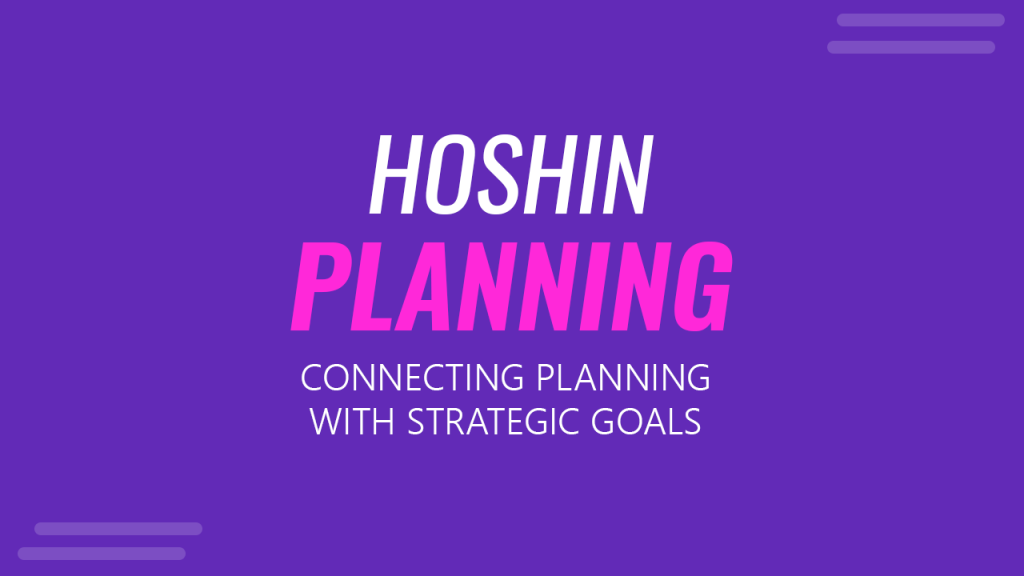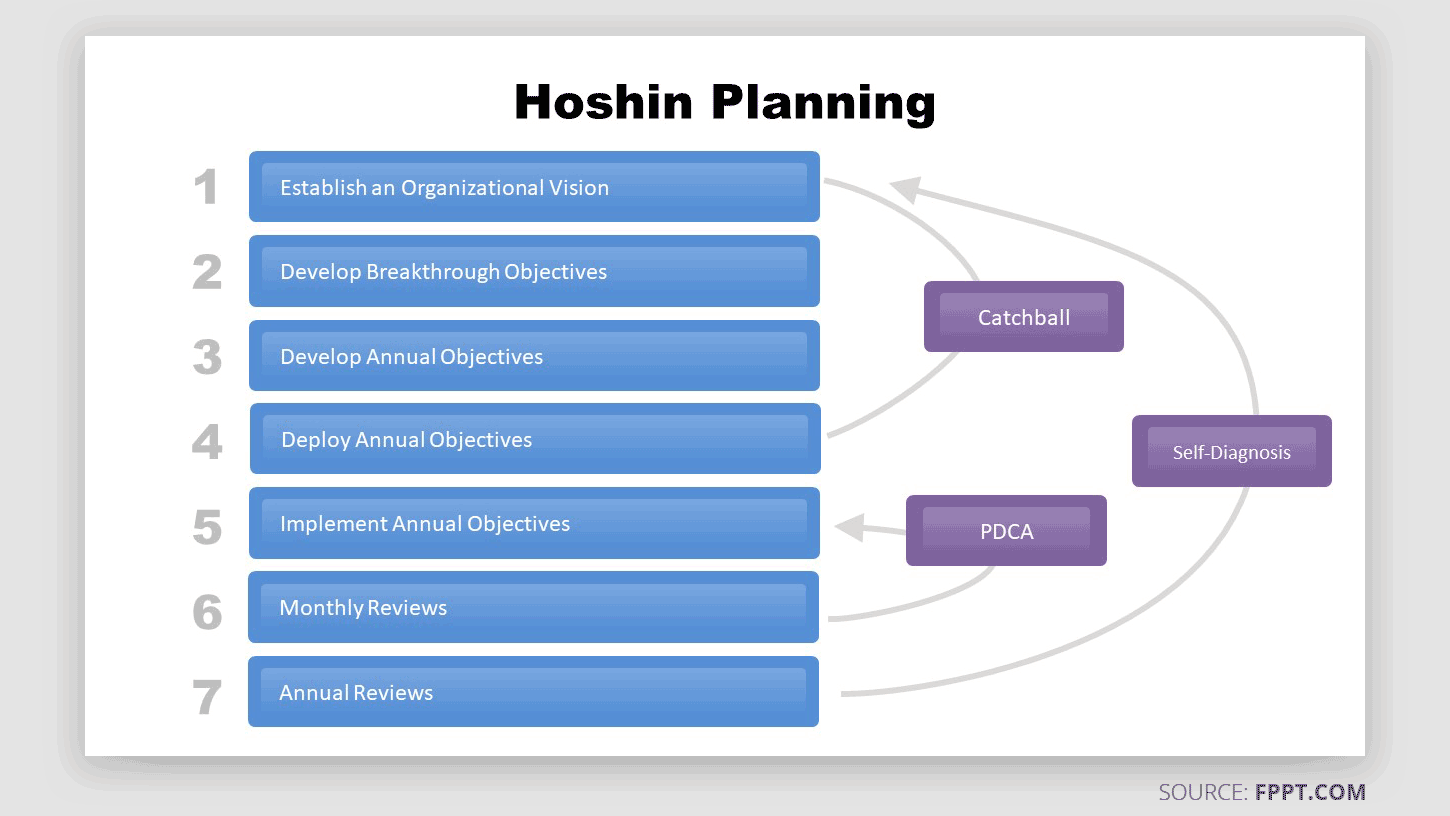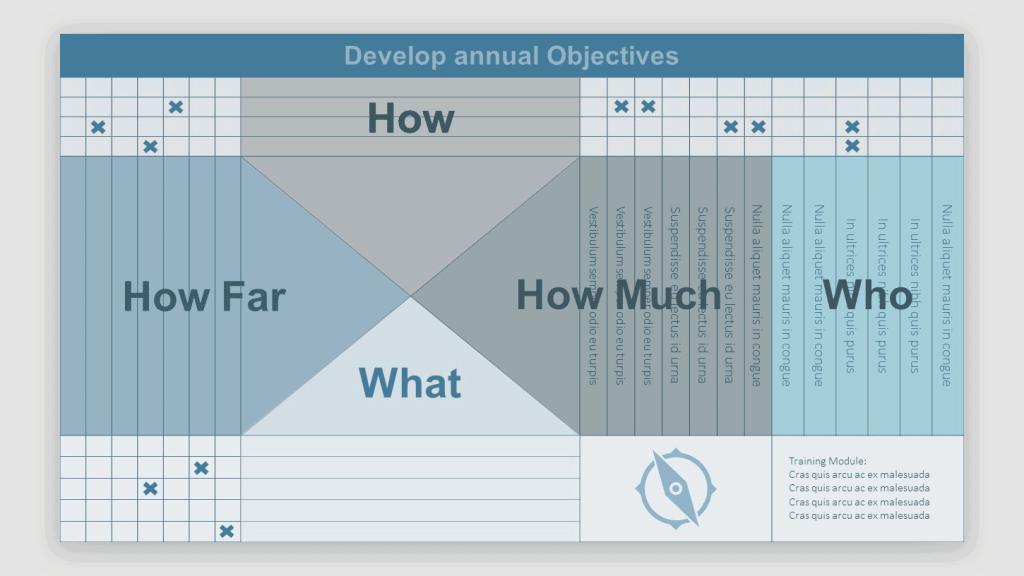Hoshin Planning: Connecting Planning with Strategic Goals

Connecting project management to realize goals associated with strategic planning can help achieve long-term goals. This is necessary in order to ensure the organization continues to propel forward, with a focus on continuous improvement. Hoshin Planning is a 7-step process used for achieving strategic goals, with an eye on long-term objectives.
What is Hoshin Planning?
Hoshin Planning comes from the Japanese term Hoshin Kanri. The word Hoshin means policy or direction, whereas the word Kanri means management. It involves planning, review, and learning activities to drive the organization towards achieving desired goals. The Hoshin Kanri approach entails a 7-step planning process where strategic goals are made actionable through an organization wide approach.
Hoshin Planning involves communicating strategic goals throughout the organization by establishing an organizational vision, developing breakthrough and annual objectives, deploying objectives, implementing annual objectives, as well as monthly, and annual reviews.
Key Components of Hoshin Planning
Hoshin Planning involves When putting the Hoshing Planning process in action, there are a number of things to consider ensuring the process itself remains focused on achieving desired results.

1. Establish an Organizational Vision
The first part of the Hoshing Planning process involves establishing a vision and mission defining the organization’s purpose. The top leadership decides the direction for the organization with 3 to 5 year goals. During the establishment of goals, it is necessary to not lose sight of why the organization exists and what is its core purpose? The Hoshing Planning method takes strategic planning to a more advanced level by also incorporating how the work of individuals in the organization will affect long-term goals and the vision itself.
2. Develop Breakthrough Objectives
The next step involves establishing strategic objectives that can support medium-term targets. These are also called breakthrough objectives. During this step, the top management and experts of the organization decide on breakthrough targets by asking three questions including:
- Why do we need to achieve the target state?
- What should be the result?
- Whereby can we tell if the target state has been achieved?
3. Develop Annual Objectives
Once the medium-term objectives have been set, employees from all functions of the organization define short-term goals for the following year. Everyone decides how they will contribute to the annual objectives. Every participant provides an overview of their contribution for feedback from the group. Through this feedback process, the goals are aligned to create a consistent picture.
4. Deploy Annual Objectives
Each member of the group goes back to their team and aims to deploy the annual objectives after discussion and alignment with their teams. This means that the goals are developed from the top and deployed across the entire organization. If an objective cannot be achieved, it is sent to the senior management with an explanation as to why it cannot be achieved.
5. Implement Annual Objectives
The annual objectives during implementation are split into smaller teams, with their own targets and goals. While each department has its own targets, the entire organization works towards a common goal, with all activities feeding into the strategic plan.
6. Monthly Reviews
During the implementation of annual objectives, the teams keep a monthly track of their progress and if they are in a position to achieve the future state. If there are any hiccups, the senior management is asked to provide feedback. This way, the senior management can help out departments and there is room for course correction.
7. Annual Review
After a year, the group meets again to check if they were able to achieve annual goals to see if short-term targets have been achieved and if they are now closer to breakthrough targets. The process of setting annual goals starts again, kick-starting the cycle to plan, review and implement short-term goals in view of the long-term objectives to be achieved as per the organization’s strategic plan.
Applications of Hoshin Planning
Hoshin Kanri involves a process that enables thinking, planning, and implementing objectives, with a constant review for course correction (if necessary). It has a variety of applications throughout various industries.
1. Identifying and Aligning Organizational Strategy for Long-Term Survival
Hoshin Planning gives strategic direction to the organization, while engaging everyone from the top to the bottom of the organizational ladder to contribute towards desired objectives. As industries and client needs change, so do the needs of companies. Be it the COVID-19 pandemic, supply side shocks affecting global economies, unprecedented inflation, or the changing world amidst the coming of age of Generation Z consumers, companies that don’t evolve today are unlikely to survive tomorrow. Hoshin Planning can help organizations keep in sight the very purpose of their existence.
Example: A manufacturing company that produces a product might need to formulate a long-term strategy to ensure they remain relevant in catering for client needs. Companies that fail to do this find it hard to survive amidst an ever-changing environment. We can argue that Nokia’s objectives did not align with market needs back in the 2000s, downgrading it from the world’s most famous mobile brand to a company that many mobile users have forgotten amidst competitive products from Apple, and Samsung. Which now seem to be threatened by Chinese manufacturers like Xiaomi and Oppo who have been increasing their global market share.
2. Playing Catch Ball to Ensure Teams are on Track
What makes Hoshin Planning quick effective is the use of catch ball method. This entails aligning organizational objectives for 3-5 years and implementation by throwing ideas up and down the hierarchy. The top management decides a direction, followed by contributions from each department, that is then taken further down the hierarchy for feedback and implementation. Throughout this process there are various reviews, such as monthly and annual reviews to ensure everything is on track.
Example: Netflix, the pioneer of subscription streaming was for a long time the industry leader. However, the market has been saturating in recent years with Amazon Prime, Disney Plus and HBO Max all looking for a stake of the subscription streaming market share. This has been happening amidst a volatile market, with subscribers switching between services irregularly. Where a small change in availability of content can lead to a major shift, affecting short-term and long-term goals. For example, Disney plus had to lower its expectations for the long-term subscribers from 230-260 million for Fiscal Year 2024 to 135 million to 165 million after it lost cricket streaming rights for the Indian Premier League, a huge draw for the audience in the country. When markets are so volatile, playing catch ball during this process can help keep things on track.
3. Gemba Approach for Strategic Alignment
Gemba or Genba is a Japanese term that means ‘the real place’. In business terms, it is the place where something valuable is created. It can be the floor of a manufacturing unit, a construction site, a showroom, etc. Hoshin Planning requires going to this place of value to see if implementation is on track. This makes the whole process more engaging, where the management can avoid losing sight of goals due to a disconnect with the ‘place of value’ in the business.
Example: Many famous brands could not survive the digital age amidst changing consumer trends. Some examples include American book retailer ‘Borders’, the former giants of the photography industry ‘Kodak’ and ‘Polaroid’ and even technology driven companies like Compaq, Motorola and Blackberry that were not ‘digital enough’ for their target market. We can argue that a lack of Gemba can be attributed towards one of the reasons for the decline of these companies. Where Hoshin Planning can potentially help prevent such a massive decline.
Best Hoshin Planning PowerPoint Templates
Hoshin Kanri Strategy PowerPoint Template
To put the Hoshin Planning process in a presentable form, you can use the Hoshin Kanri Strategy PowerPoint Template. With this template, you can explain the Hoshin Planning process, showcase the organization’s strategic plan, discuss and develop a planning cycle, etc. This strategic plan template also has a catchballing slide that shows the process of ideas floating back and forth, making it easier for the audience to grasp the process of review and course correction.

This presentation templates contains a slide with the X Matrix, which is part of Hoshin Planning tool.

Final Words
With a combination of strategic planning with sight on long-term goals, periodic reviews, and learning activities, Hoshin Planning provides a comprehensive tool for keeping an organization on track to achieve set objectives. Hoshin Planning can be an effective mechanism to avoid a disconnect between not only the senior management and people down the hierarchy but also between different departments of an organization. Aligning the whole organization towards a direction, with small teams focusing on specified goals, without losing sight of the big picture.
